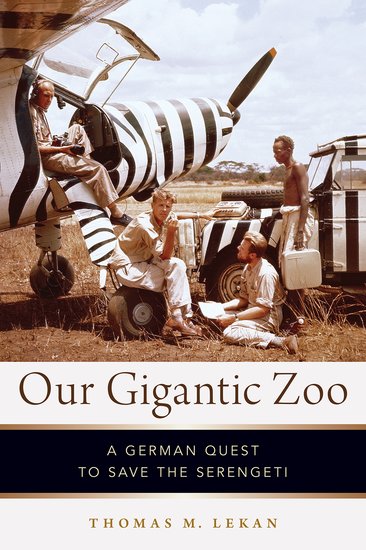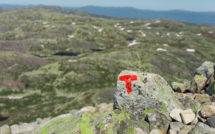
 This is part of our special feature, Rethinking the Human in a Multispecies World.
This is part of our special feature, Rethinking the Human in a Multispecies World.
Thomas M. Lekan’s monograph Our Gigantic Zoo examines the nexus of environmentalism and decolonization to shed light on the political and economic interests behind the construction of a seemingly uncompromised piece of nature. The book underlines the role of mass media, public opinion, tourism, international and inter-imperial diplomacy, and green networks in the diffusion of global environmentalism. By analyzing a period of massive political transition, Lekan emphasizes the instability and malleability of natural resources that are compounded by uneven colonial legacies and processes of nation building. Lekan aptly shows how what appears at first glance as “natural” nature is, in fact, an outcome of divergent ideologies, political and economic forces, and negotiations.
To tell this story, Our Gigantic Zoo traces the involvement of the former Frankfurt Zoo director and Oscar-winning documentarist Bernhard Grzimek in the making of the Serengeti National Park in Tanzania around the 1960s. Projecting onto East Africa West German anxieties about Americanization and environmental destruction, Grzimek, and his son and partner Michael, viewed this “gigantic zoo” as needing protection from modernization and overpopulation pressures. The Grzimeks’ outlook was in tension, at times in alignment, with rural Africans’ land use customs; with the national aspirations and goals of African politicians; and with other colonial European forces, particularly the British conservation cadre stationed in Tanzania. Lekan suggests that Grzimek saw himself as an agent of a global, nonpartisan, mission to save nature. This seemingly apolitical endeavor depended on his skills in forging alliances between Western environmentalists and African leaders. Working together with a network of conservationists, Grzimek presented himself as an “honest broker,” a globalist devoid of Cold War loyalties or colonial ties. His hope was to ensure a steady supply of Western Safari tourists to East Africa, which would generate revenue for emerging African states while funding the protection of the Serengeti. This cohered with the developmental vision of Julius Nyerere, the leader of Tanzania’s (then Tanganyika) national movement, who needed the investment of Western tourists. Grzimek also believed that these tourists’ money could substitute for Tanzania’s potential earnings from agricultural and mining exports.
Accordingly, Grzimek worked to construe the image of the Serengeti as a natural haven. Paradoxically, it is as a result of technological interventions that the park came to be seen as a haven shielded from the claws of modernity. In order to “truly see” the Serengeti, the Grzimeks deployed aerial footage of the park. Through documenting the Serengeti, and launching a series of surveys and vegetation analyses of the area, the Grzimeks learned about and commodified the park. The image of the Serengeti as a natural haven was further solidified in the Grzimeks’ film The Serengeti Shall Not Die(1959), which displayed the aerial footage to a wide western audience. As Lekan argues, The Serengeti Shall Not Die “had left its mark by transforming an ecosystem into a resilient protagonist—and potent commodity—that remained vibrant despite fires, downpours, diseases, and human encroachment” (256). The film encouraged western viewers to donate to and visit the park. In this sense, to the visitor or film viewer, the Serengeti was nature. It was an authentic piece of the natural world, salvaged from human intervention, whether European, colonial, or African.
Importantly, Lekan demonstrates how the aerial panoramic view of the Serengeti and its commodification, which ensured the park’s integrity as a fixed image, were not able to efface the much more fluid reality on the ground. Much like the political decolonization of East Africa, the decolonization of its natural resources maintained power relations of the colonial era, through paternalistic intervention. The efforts of Grzimek and other international conservationists to maintain a global, but essentially Western, outlook of the park—which at first created an alliance with Nyerere—soon came into confrontation with Nyerere’s national aspirations and plans for Tanzania. The Africanization and nationalization of the park in the early 1970s, demarcated new, more national, contours of the Serengeti, replacing global ones. Moreover, the Serengeti’s establishment encroached on the territorial possessions of rural peoples, notably the Masaai. Framed around the question of authenticity of the human inhabitants of the land—European actors, from British colonial officials to international conservationists—the debate engaged the extent to which indigenes owned the right to inhabit and use the land. The Europeans’ obsession with so-called authentic “noble savages”—the original inhabitants of the park—led to contrasting views about the mission of the park. Some Europeans viewed the Maasai as “part of the ‘fauna’ of the national parks that deserved protection from the encroachment of modernity,” (148), while others regarded them as land-users who corrupted the land and competed with local animals for resources. The latter group contended that any attempt to “appease” the Maasai would serve as a dangerous precedent that would be detrimental to the integrity of national parks across the world. The question of global nature emerges here as a question of ownership. More specifically, of the identity of the owner and the identity of the owned. Ultimately, the Grzimeks, as well as the German- and English-speaking visitors of the Serengeti, treated themselves as the rightful “owners” of the “zoo.” They saw themselves as global citizens who—through the film and visits to the national park—could truly see nature in its global dimensions, and understand the importance of a place like the Serengeti for the survival of the planet and the human species.
For historians, Our Gigantic Zoo is a major contribution on the emergence of environmental consciousness. The book highlights the understudied internationalization of environmentalism outside the Anglo-American sphere, where it has received more scholarly attention. Although Germany lost its African colonies in 1919, the book shows that this lack of direct colonial control underlined the elusive ways in which Europeans and Africans worked, together or in conflict, to manage natural resources at the outset of decolonization. The German story enables us to focus our attention on the ways in which global environmentalism emerged out of a tendency of what Lekan calls “thinking locally and acting globally.” Lekan contends that Grzimek and his collaborators universalized scientific and moral claims about nature formulated from their own “situated space of knowledge, power, and material relations” in West Germany (10). This tendency to “think locally and act globally” can be traced as far as the first encounters of Europeans with Native Americans at the end of the fifteenth century. But in the context of decolonization and the post-WWII world, it acquires new meanings. These meanings have to do with European efforts to directly control and exploit natural resources, more than with the interplay between African efforts to assert control over these resources and European anxieties about catastrophes produced by technological innovations. Carrying with him his experiences of war, reconstruction, and Americanization in Europe, Grzimek saw the rapid urbanization of decolonizing East Africa as a dangerous repetition of Europe’s ecological mismanagement. Indeed, as Lekan argues, the success of Grzimek’s project had to do in part with the fact that his depiction of East Africa resonated with West Germans’ anxieties about modernization in postwar Europe. Furthermore, post-Hitler Germans, who were seeking to redeem themselves in the global community, were particularly receptive to environmental protection, believing it to be an ethical duty that could allow the country to reclaim cultural leadership in the global community. It is Grzimek’s relative success in maneuvering intricate local and global networks that makes his story an important lens for examining the internationalization of environmentalism in the context of post-world war and decolonization processes. Our Gigantic Zoo will be of interest to scholars working at the nexus of the environment and colonialism, as well as to European historians and all researching questions concerning nature and animals within culture.
Yotam Tsal (PhD from the University of California, Berkeley) is a Lady Davis Postdoctoral Fellow at the Hebrew University of Jerusalem.
Our Gigantic Zoo: A German Quest to Save the Serengeti
By Thomas M. Lekan
Publisher: Oxford University Press
Hardcover / 348 pages / 2020
ISBN 9780199843671
Published on November 9, 2021




